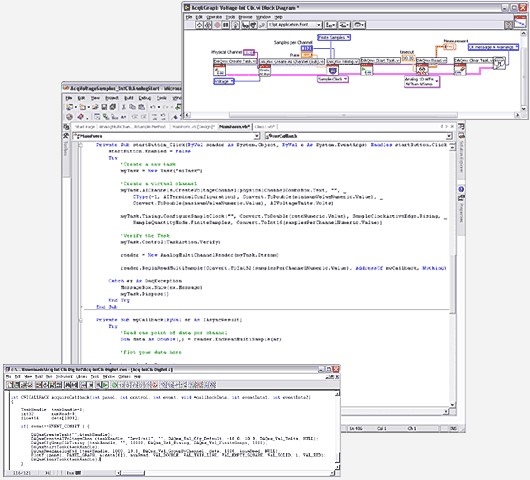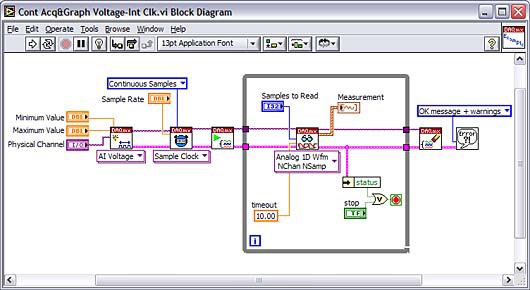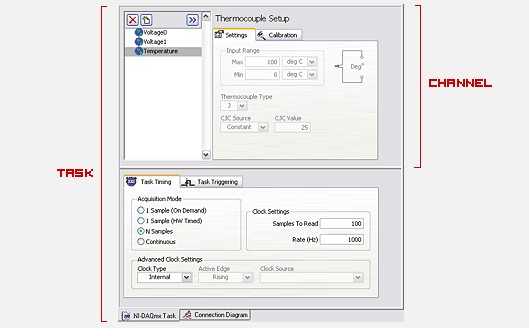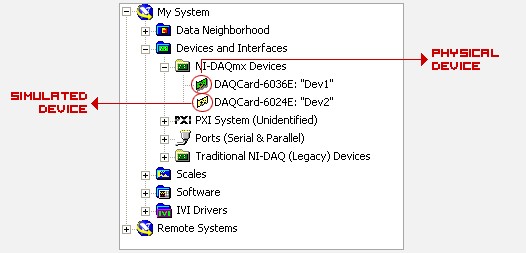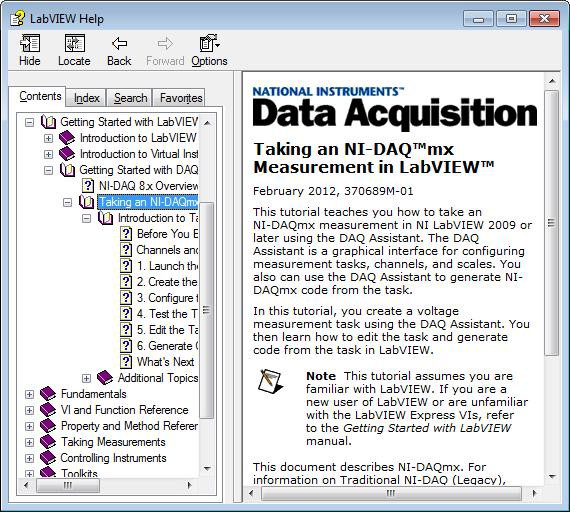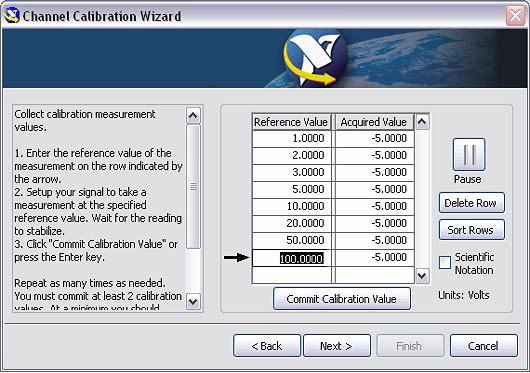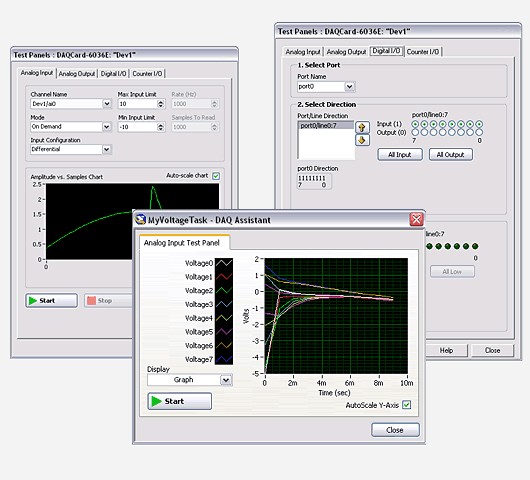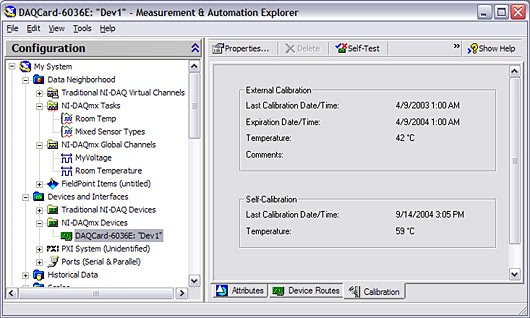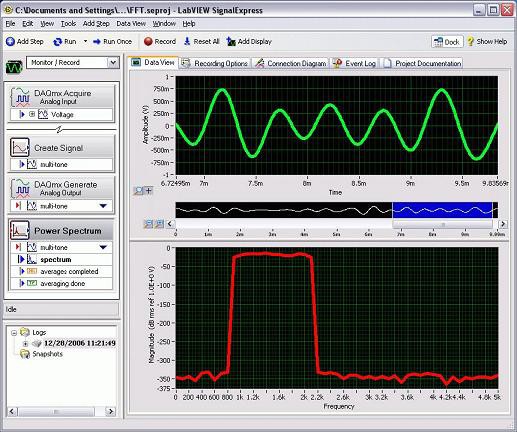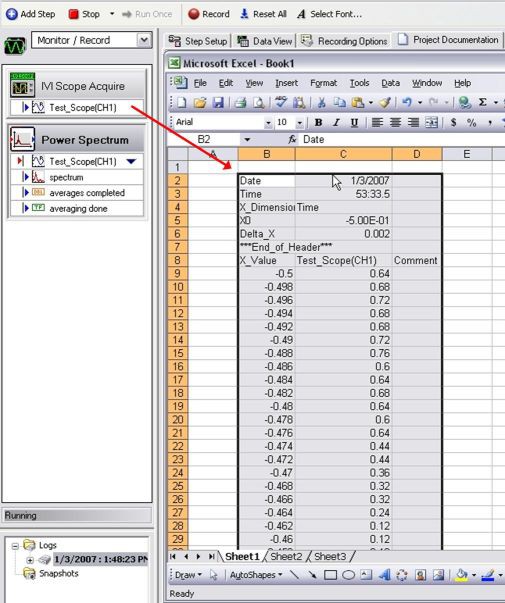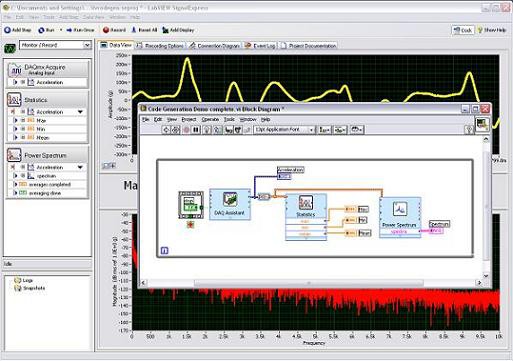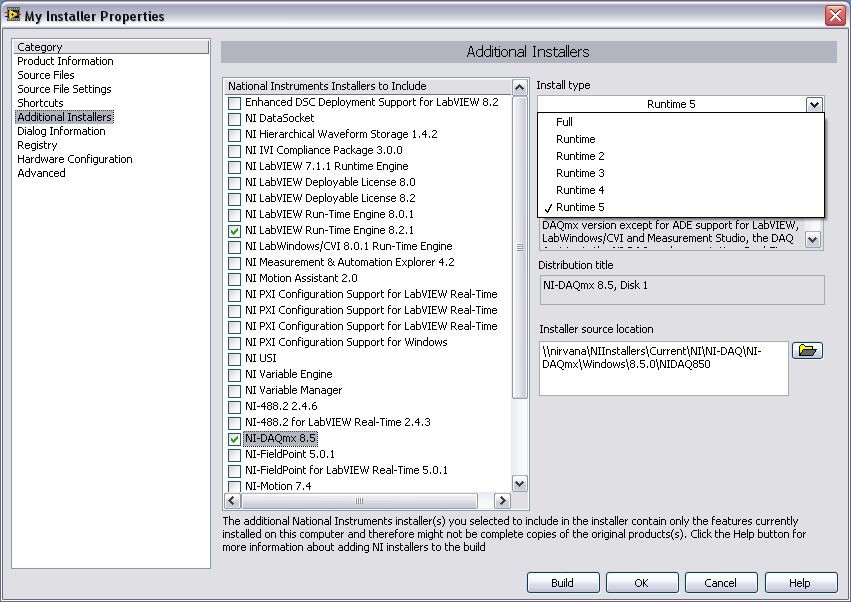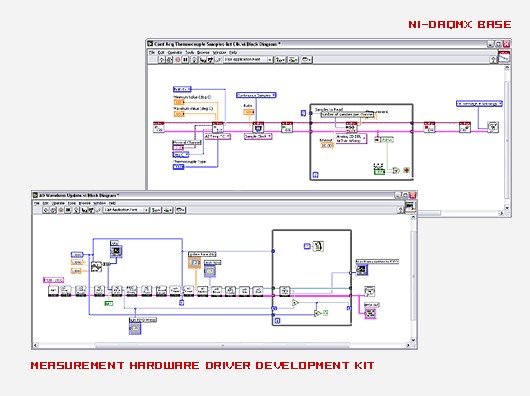NI-DAQmx Software Services Feature Gallery
Overview
Explore the measurement services software included with the latest NI data acquisition hardware.
Contents
- One Interface, Many Programming Languages
- One Interface, Hundreds of Data Acquisition Devices
- Tasks and Global Virtual Channels
- Polymorphic VIs
- NI-DAQmx Simulated Devices
- NI-DAQmx Documentation
- DAQ Assistant Express VI
- Connection Diagram
- Channel Calibration Wizard
- Test Panels
- Device Calibration
- FREE Data-Logging Software
- Exporting Data
- Generate LabVIEW Code
- Configurable Deployment Options
- Other Driver Options
NI provides valuable measurement services software with data acquisition devices. This measurement services software reduces the time costs that make up two-thirds of the total costs associated with data acquisition and logging application creation.
One Interface, Many Programming Languages
LabVIEW has emerged as a standard for developing virtual instrumentation test, measurement, and control applications. However, NI-DAQmx measurement services software also provides the same interface for other popular programming languages, including Visual Studio .NET languages, C, and C++. The functions and properties, as well as the order of the functions you use, are the same across all languages. This feature is most useful when a single project team is using multiple programming languages and eases the transition from one language to another for developers.
One Interface, Hundreds of Data Acquisition Devices
NI-DAQmx provides a single programming interface for hundreds of data acquisition devices so you only have to learn the interface once. Whether you are developing with an NI M Series USB device or an NI S Series PCI device, the basic data acquisition code is the same. With a single programming interface, you can easily upgrade or switch hardware without changing your code.
Tasks and Global Virtual Channels
Global virtual channels are software entities that encapsulate the physical channel along with other channel-specific information, such as range, terminal configuration, and custom scaling. A task is a collection of one or more channels as well as the timing, triggering, and other properties that apply to the task itself. By creating virtual channels and tasks with the DAQ Assistant, you can ensure easy management and reuse of your measurement and generation tasks.
Polymorphic VIs
The NI-DAQmx programming interface makes it easy to develop complex data acquisition applications by providing identical functions and VIs for all types of operations. For example, rather than using a Digital Read function to read data from digital lines and an Analog Read function to read analog data, you use one function to read both digital and analog data. Functions like these, known as polymorphic functions, take on different characteristics based on their input values. The combination of functions into one interface results in a flatter learning curve for you, not only for one device but also for an entire family of devices. Rather than learning four different ways to program the four types of operations (analog input, analog output, digital I/O, and counter/timer) available on NI's DAQ devices, you can now learn one way and reuse that knowledge to program the others.
NI-DAQmx Simulated Devices
NI-DAQmx simulated devices are useful for creating and running NI-DAQmx programs and for trying out tools such as the DAQ Assistant or NI LabVIEW SignalExpress without using any physical hardware. You also can use NI-DAQmx simulated devices for discovering device capabilities without the physical hardware because you can verify NI-DAQmx tasks on simulated devices just as you would on real devices. If a property is set to an invalid value, the error returned for a simulated device is identical to the error returned for a real device. Like real devices, NI-DAQmx simulated devices count and reserve all necessary task resources, such as RTSI lines, PXI trigger lines, DMA channels, counters, and more.
NI-DAQmx Documentation
NI-DAQmx is installed with hundreds of pages of documentation and reference material, as well as dozens of example programs to help you get started with your data acquisition application.
Subjects covered include the following:
- Programming interface references for function and property nodes
- Program language-specific help for NI-DAQmx task creation
- Measurement fundamentals references covering a variety of data acquisition topics such as buffers, device synchronization, and signal conditioning
- Common data acquisition application descriptions
DAQ Assistant Express VI
The DAQ Assistant, bundled with NI-DAQmx for Windows, provides a step-by-step guide for configuring, testing, and programming measurement tasks. You also can automatically generate example programs based on your configuration for low-level customization. In addition to other configuration-based VIs in LabVIEW, the DAQ Assistant Express VI makes it easier and faster to develop data acquisition applications.
The DAQ Assistant is available for use with NI-DAQmx, NI data acquisition hardware, and NI application software including LabVIEW, LabVIEW SignalExpress, LabWindows/CVI, and Measurement Studio.
Connection Diagram
Simplify system setup by using connection diagrams to pinpoint where to connect your sensor based on the DAQ Assistant task configuration. Each virtual channel is accompanied by an image illustrating the needed connections from the sensor to the connector block. The connections list also displays each of the connections in text format, specifying terminal names and numbers.
Use the Save as HTML option in the Connection Diagram tool to save an HTML report of your task. The report contains the following items:
- List of virtual channels in the task
- Physical channels
- Device types
- Measurement types
- Connection diagrams
Channel Calibration Wizard
Use the Channel Calibration Wizard to do end-to-end calibration from your sensor to your software. For example, if you have a thermocouple in an ice bath that should be reading 0 ºF but is reading -1 ºF, you may have a bad sensor, your multifunction I/O device may need to be calibrated, or you may need to reduce noise in the cable. Channel calibration takes sensors, hardware, and measurement software into account and applies compensation to the measurement in addition to all scaling and hardware calibration, thus improving measurement accuracy. The Channel Calibration Wizard stores a set of calibration properties for each virtual channel you calibrate.
Test Panels
Use test panels to test your DAQ device functionality without any development. Each major DAQ device subsystem has a test panel:
- analog input
- analog output
- digital input
- digital output
- counter/timers
Acquiring and generating data to test your device using test panels can save considerable time during your application development and debugging phases. You can execute NI-DAQmx tasks through a test panel to confirm the desired behavior of a configured task.
Device Calibration
Device calibration consists of verifying the device's measurement accuracy and adjusting for any measurement error. Verification consists of measuring the device's performance and comparing these measurements to the published specifications. During calibration, you supply and read voltage levels or other signals using external standards, and then you adjust the device calibration constants. The new calibration constants are stored in the EEPROM. These calibration constants are loaded from memory as needed to adjust for the error in the measurements the device takes. There are two kinds of calibration, external and self. For more information on calibrating your device with NI-DAQmx, refer to the calibration device considerations.
- Self-Calibration (Internal Calibration): Self-calibration adjusts the calibration constants with respect to an onboard reference stored on the device. You can perform a self-calibration at any time to adjust the device for use in environments other than those in which the device was externally calibrated.
- External Calibration: External calibration, which is typically performed by a metrology lab, requires using a high-precision voltage source to verify and adjust calibration constants.
FREE Data-Logging Software
LabVIEW SignalExpress provides an interactive measurement workbench for quickly acquiring, analyzing, and presenting data from hundreds of data acquisition devices and instruments, with no programming required. Use the intuitive drag-and-drop environment to instantly acquire data, perform advanced analysis and create custom reports with LabVIEW SignalExpress. With included support for hundreds of data acquisition, modular and stand-alone instruments, you can quickly automate your data logging and instrument control applications.
Automatic Device Detection
NI LabVIEW SignalExpress automatically detects NI USB DAQ devices and immediately launches a data-logging application based on the measurements being made. By combining NI DAQ devices with LabVIEW Signal Express you can make your measurements quickly.
Channel View
For quick setup and configuration, LabVIEW SignalExpress has a Channel View you can use to simultaneously configure multiple channels for logging. Using the Channel View, you can configure a multi-channel data logger and make various types of measurements quickly.
Data View
The Data View of LabVIEW SignalExpress is the main window for presenting the acquired data and analysis. You have the option of customizing the Data View by adding graphs, charts, thermometers, meters, gauges, and LEDs. You can create your display in the Data View while the application is running by dragging the data from the applicable step into the Data View.
Exporting Data
LabVIEW SignalExpress simplifies many common data logging tasks, including exporting your data. You can export to common Windows applications, such as Microsoft Excel, by either right-clicking your data or dragging and dropping your data from LabVIEW SignalExpress into Excel. LabVIEW SignalExpress automatically formats the data and applies column headers. LabVIEW SignalExpress also supports streaming of your acquired data in the TDMS (Technical Data Management Streaming) format. The TDMS format adds descriptive information to your bulk data to allow for complete documentation of your saved data, such as operator name, data and time, and various other test parameters. TDMS files are also optimized for data mining to help you quickly search, find, analyze, and present your test data in an off-line data mining tool such as NI DIAdem.
Generate LabVIEW Code
Because LabVIEW SignalExpress is based on LabVIEW, you can automatically generate LabVIEW code and add custom functionality through graphical programming. With LabVIEW, you can target multiple hardware platforms such as FPGAs, DSPs, and Embedded devices.
Configurable Deployment Options
Many deployed LabVIEW and NI LabWindows/CVI data acquisition applications do not require support for all of the functionality of the NI-DAQmx driver and utilities. With NI-DAQmx 8.5, you now have the ability to deploy five different runtime versions of NI-DAQmx, ranging from the full-featured 617 MB driver to a size-optimized 169 MB runtime engine. The following sections describe the five different options you have for NI-DAQmx runtime engines when building executables.
The following procedure will allow you to access the custom installer capabilities:
- On your target machine, create and save your NI-DAQmx application into a new LabVIEW project.
- From the Project Explorer, right-click on Build Specifications and select New > Installer.
- In the installer properties window, click on Additional Installers under Categories.
- Select NI-DAQmx 8.3 or later, and select the Installer Type from the drop-down list in the top-right of the window.
Full (617 MB)
This distribution installs all the driver software included in NI-DAQmx but does not include:
- NI LabVIEW SignalExpress
This is the default selection when building a custom installer which includes NI-DAQmx.
Runtime 1 (494 MB)
This distribution installs all the driver software included in NI-DAQmx but does not include:
- NI LabVIEW SignalExpress
- Application development environment (ADE) support for LabVIEW, LabWindows/CVI, and NI Measurement Studio
If you have used the DAQ Assistant in any of the development of the deployed application, use this option when creating the NI-DAQmx installer.
Runtime 2 (375 MB)
This distribution installs all the driver software included in NI-DAQmx but does not include:
- NI LabVIEW SignalExpress
- Application development environment (ADE) support for LabVIEW, LabWindows/CVI, and Measurement Studio
- The DAQ Assistant
Runtime 3 (315 MB)
This distribution installs all the driver software included in NI-DAQmx but does not include:
- NI LabVIEW SignalExpress
- Application development environment (ADE) support for LabVIEW, LabWindows/CVI, and Measurement Studio
- The DAQ Assistant
- NI-DAQmx documentation
Runtime 4 (305 MB)
This distribution installs all the driver software included in NI-DAQmx but does not include:
- NI LabVIEW SignalExpress
- Application development environment (ADE) support for LabVIEW, LabWindows/CVI, and Measurement Studio
- The DAQ Assistant
- NI-DAQmx documentation
- LabVIEW Real-Time support
Runtime 5 (169 MB)
This distribution installs all the driver software included in NI-DAQmx but does not include:
- NI LabVIEW SignalExpress
- Application development environment (ADE) support for LabVIEW, LabWindows/CVI, and Measurement Studio
- The DAQ Assistant
- NI-DAQmx documentation
- LabVIEW Real-Time support
- Measurement & Automation Explorer (MAX)
Other Driver Options
NI-DAQmx Base
NI-DAQmx Base offers a subset of NI-DAQmx functionality on Windows, Linux, Mac OS X, and Pocket PC OSs. Simplify application development by using the clean, concise programming interface, programmatic channel and task creation, and tight NI LabVIEW integration. This driver software also includes ready-to-use LabVIEW VIs and C function examples similar to those in the full-featured version of NI-DAQmx driver software.
NI-DAQmx Base is now EOL. For more information, please read the End-of-Life Announcement for DAQmx Base Driver.
Measurement Hardware Driver Development Kit (DDK)
The NI Measurement Hardware DDK provides development tools and a register-level programming interface for NI data acquisition hardware. This package is designed for OEM customers who are developing applications that require nonstandard OSs. The NI Measurement Hardware DDK provides access to a full register map of each device and offers examples for completing common measurement and control functions. The Measurement Hardware DDK works with M Series multifunction, analog output, digital I/O, and counter/timer I/O devices.
